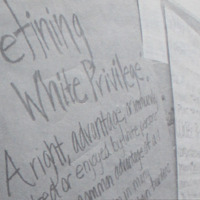Loyola Phoenix: 'White privilege' sign sparks student uproar
Item
Title
Loyola Phoenix: 'White privilege' sign sparks student uproar
Description
This photo by Nick Kocmich appears in an article by Dianna Heitz that addresses responses to a bulletin board created by R.A.s in Mertz Hall. The three R.A.s (resident assistants) created it "in an attempt to promote a better understanding of inequalities and injustices pertaining to race relations" and posted it on the second floor of Mertz Hall near the elevators. The messages on the board were based on an article titled "White Privilege and Male Privilege: A Personal Account of Coming to See Correspondences Through Work in Women's Studies" by former Loyola Women's Studies professor Peggy McIntosh.
According to the article, the bulletin board (which features in the photograph) "displayed numerous white privileges described in McIntosh's article, a definition of white privilege and instances in the media of white privilege. For example, the differences in the portrayal of black and white women in film were shown using the moves 'The First Wives Club' and 'Waiting to Exhale.'
In the article, McIntosh defines white privilege as 'an invisible package of unearned assets that [Caucasians] can count on cashing in each day, like special provisions, assurances, tools, map guides, code books, and blank checks.'
McIntosh says 'white privilege' gives certain unfair privileges to white individuals over minorities."
"Many Mertz Hall residents, however, said they were confused with the board's message and purpose. The board's topic also sparked a controversy among students.
A forum took place Feb. 11 in Mertz Hall's West Lounge to discuss the controversy, according to one R.A." to discuss positive and negative reactions to the board and clarify its purpose.
A program coordinator for the department of student development and diversity, as well as sociology professor Emily Ignacio, attended to facilitate an open discussion on race relations and the implications of the board.
"Roughly 40 people of different ethnicities attended the forum and filled West Lounge for the 90-minute discussion.
"Many students simply wanted to know why the board was put up during Black History Month.
Some students came to the forum in search of a better understanding of what they consider to be the definition of white privilege."
"Many African American students told stories of what it felt like to experience racism firsthand. Some students said they had witnessed white privilege, while others felt they had been given privileges because of their skin color." Others doubted that the sign would have any impact.
Ignacio urged participants to continue this type of open dialogue.
According to the article, the bulletin board (which features in the photograph) "displayed numerous white privileges described in McIntosh's article, a definition of white privilege and instances in the media of white privilege. For example, the differences in the portrayal of black and white women in film were shown using the moves 'The First Wives Club' and 'Waiting to Exhale.'
In the article, McIntosh defines white privilege as 'an invisible package of unearned assets that [Caucasians] can count on cashing in each day, like special provisions, assurances, tools, map guides, code books, and blank checks.'
McIntosh says 'white privilege' gives certain unfair privileges to white individuals over minorities."
"Many Mertz Hall residents, however, said they were confused with the board's message and purpose. The board's topic also sparked a controversy among students.
A forum took place Feb. 11 in Mertz Hall's West Lounge to discuss the controversy, according to one R.A." to discuss positive and negative reactions to the board and clarify its purpose.
A program coordinator for the department of student development and diversity, as well as sociology professor Emily Ignacio, attended to facilitate an open discussion on race relations and the implications of the board.
"Roughly 40 people of different ethnicities attended the forum and filled West Lounge for the 90-minute discussion.
"Many students simply wanted to know why the board was put up during Black History Month.
Some students came to the forum in search of a better understanding of what they consider to be the definition of white privilege."
"Many African American students told stories of what it felt like to experience racism firsthand. Some students said they had witnessed white privilege, while others felt they had been given privileges because of their skin color." Others doubted that the sign would have any impact.
Ignacio urged participants to continue this type of open dialogue.
Date, date span, or circa acceptable
2003-02-19
File name
Loyola Phoenix, 2003-02-19, page 11, 'White privilege' sign sparks student uproar
Sources archive, University Archives and Special Collections or Women and Leadership Archives
University Archives and Special Collections
Source
University Archives and Special Collections, Loyola Phoenix, 2003-02-19, page 11, 'White privilege' sign sparks student uproar
Subject
Loyola University Chicago
Student life
Rights
Contact the Loyola University Chicago Archives and Special Collections, archive@luc.edu, for permission to copy or publish.

